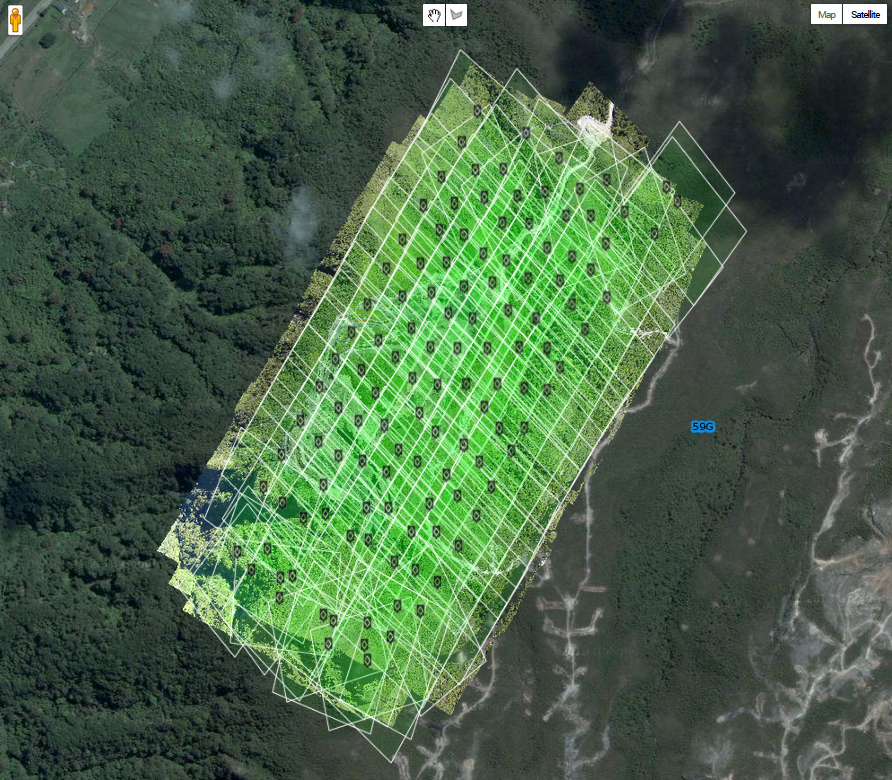We’ve generated a heatmap showing some of the UAV hot spots around the globe. Data is a random sampling of 30,000 records from our imagery database.

We’ve generated a heatmap showing some of the UAV hot spots around the globe. Data is a random sampling of 30,000 records from our imagery database.

We’ve implemented some basic data collection quality assurance and quality control tools inside the DroneMapper web interface. For each flight uploaded, we now generate an image footprint polygon layer. The polygons are oriented by obtaining the bearing between Latitude and Longitude points along the flight line, the size of the polygon is computed using the ground sample distance (GSD), sensor size and image size. The intention is to give you an idea of the overlap and imagery coverage over the area of interest, clearly showing large holes or gaps in the flight data collection. Other additions include basic EXIF geo-tag sanity checks such as unique Latitude and Longitude, consistent focal length, shutter speed / exposure time and missing altitude tags.
QA/QC Checks:

Image Footprint Polygons:
The image below represents an ideal data collection courtesy of Morgan from New Zealand. The flight is over mountainous terrain and has large areas of homogeneous ground cover. The image footprint polygons are visible and highlight the overall quality of the data collection. Morgan provides some additional information, and tips for other operators:

“If people ask you for tips and you don’t already know the following then feel free to tell them that flight was at 75% overlap, flown into and with the wind (so I got less crabbing of the air frame). I also triggered the camera based on distance, not time, so shot spacing was consistent. I also set the camera to program mode (not auto), set my (White Balance) WB to cloud or sunny (not auto) and ensure my shutter speed is above 1/1200. Camera is a SX260HS loaded with a CHDK script Jeff Taylor made – here’s a link: http://diydrones.com/profiles/blogs/apm-to-chdk-camera-link-tutorial” –Morgan
We’ve made some changes and improvements to the DroneMapper Aerial Imagery Processing service as of 02-21-2014.


Please contact us if you have any questions or comments!
We’ve added orthomosaic seamline detection and blending enhancement algorithms to the DroneMapper processing service. The routines have been tested on NIR imagery and RGB visible imagery with great results. These improvements significantly improve the overall visual appeal of our orthomosaic products without compromising the resulting geo-referenced NDVI or radiometrics. Please contact DN2K, AgEagle or DroneMapper for your precision agriculture needs. The NIR data set below is courtesy of DN2K and AgEagle.
DroneMapper has implemented blending and smoothing algorithms in order to eliminate or at least significantly minimize the appearance of seamlines in orthomosaics. Figure 1) shows a field imaged in the NIR with seamlines apparent throughout the field. A seamline detection algorithm was utilized to identify edges (shown in Figure 2) between processed tiles and apply a blending or feathering of the radiance at these seams. Figure 3 illustrates the result of incorporating this technique. The majority of seamlines have been significantly smoothed offering a more visually appealing scene. Figures 4 and 5 show the same area of the ortho at higher resolution before and after the technique was applied.
(Figure 1) Original Orthomosaic:
(Figure 2) Seamline detection:
(Figure 3) Orthomosaic with seamline detection and removal:
(Figure 4) Original Orthomosaic:
(Figure 5) Orthomosaic with seamline detection and removal:
Geo-Referenced Enhanced NDVI and Traditional NDVI:
DroneMapper is supporting Delta County teen tech week starting March 9th. We are looking for a UAV operator in Western Colorado who would like to give a demo of their platform to the local teenagers. Please let us know if you are interested!
"The program runs the week of March 9th and is intended to introduce teenagers to various types of technology in the hopes of encouraging them to pursue careers in the tech domain."